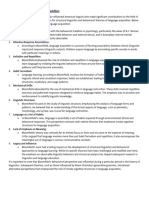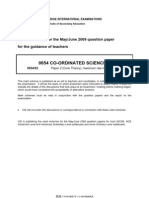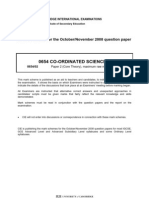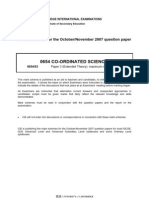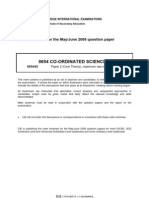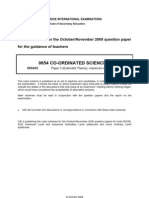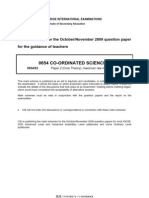0653 w15 Ms 33
0653 w15 Ms 33
Uploaded by
yuke kristinaCopyright:
Available Formats
0653 w15 Ms 33
0653 w15 Ms 33
Uploaded by
yuke kristinaOriginal Title
Copyright
Available Formats
Share this document
Did you find this document useful?
Is this content inappropriate?
Copyright:
Available Formats
0653 w15 Ms 33
0653 w15 Ms 33
Uploaded by
yuke kristinaCopyright:
Available Formats
CAMBRIDGE INTERNATIONAL EXAMINATIONS
Cambridge International General Certificate of Secondary Education
MARK SCHEME for the October/November 2015 series
0653 COMBINED SCIENCE
0653/33 Paper 3 (Extended Theory), maximum raw mark 80
This mark scheme is published as an aid to teachers and candidates, to indicate the requirements of
the examination. It shows the basis on which Examiners were instructed to award marks. It does not
indicate the details of the discussions that took place at an Examiners meeting before marking began,
which would have considered the acceptability of alternative answers.
Mark schemes should be read in conjunction with the question paper and the Principal Examiner
Report for Teachers.
Cambridge will not enter into discussions about these mark schemes.
Cambridge is publishing the mark schemes for the October/November 2015 series for most
Cambridge IGCSE, Cambridge International A and AS Level components and some
Cambridge O Level components.
IGCSE is the registered trademark of Cambridge International Examinations.
Page 2 Mark Scheme Syllabus Paper
Cambridge IGCSE October/November 2015 0653 33
1 (a) large ;
into ;
capillaries ; [3]
(b) smaller airway diameter ;
presence of mucus obstructing flow ; [2]
(c) (i) 12.5 5.8 = 6.7 (dm3 / min) ;
6.7
100 = 115(%) or 116(%) ;
5.8
or
12.5
= 215 ;
5.8
215 100 = 115 (%) ; [max 2]
(ii) to get more oxygen (into the blood) / remove more carbon dioxide ;
for respiration ; [2]
(d) (cilia become paralysed)
mucus cannot be shifted upwards ;
airways become even more restricted / more mucus for bacteria to breed in /
bacteria / tar will not be removed from the lungs / increases risk of bronchitis ;
or
(more mucus is produced)
airway becomes even more restricted / blocked ;
more mucus for bacteria to breed in / remain in lungs / increases chances of
chest infections / reduces oxygen supply for the body ; [max 2]
[Total: 11]
2 (a) thermal energy to chemical energy ; [1]
(b) (i) steeper gradient than solid line ; [1]
(ii) increasing concentration increases rate of reaction ;
increased frequency of collisions ; [2]
(c) (i) atoms ions
ions atoms ; (must be in this order) [1]
(ii) silver written below copper ; [1]
(iii) the atoms of more reactive metals become ions more readily than those of
less reactive metals ; [1]
[Total: 7]
Cambridge International Examinations 2015
Page 3 Mark Scheme Syllabus Paper
Cambridge IGCSE October/November 2015 0653 33
3 (a) weight / gravitational force (accept gravity) ; [1]
(b) (gravitational) potential (energy) to kinetic (energy) ; [1]
(c) (i) accelerating ;
constant speed ; [2]
(ii) area under graph between A and C or ( 2 9) + (2 9) or (2+4) 9 ;
= 27 (m) ; [2]
(d) particles far apart in air / gas, but close together / touching in water / liquid
(accept diagrammatic description) ;
stopping the skateboarder requires loss of KE ;
more work done / loses more KE / more difficult to push water particles aside
than pushing air particles aside / owtte / diagrams ;
harder to push water molecules apart because of the forces between them / more
particles ; [max 3]
[Total: 9]
4 (a) (i) contains the correct proportions of nutrients for an individual ; [1]
(ii) to prevent scurvy / AVP ; [1]
(b) (i) as temperature increases the amount of vitamin C decreases ; [1]
(ii) rate / amount of decomposition / breakdown / disappearance increases with
temperature ; [1]
(iii) temperature will vary in different parts of the world ;
this will affect the amount of vitamin C (in fruit before the experiment) ;
OR
amount of water given / contained in1 fruit may vary ;
this could affect concentration of the fruit juice ;
OR
different variety of orange / fruits vary genetically ;
(naturally) contains different amounts of vitamin C ;
AVPs ;; [max 2]
(c) boiling water destroy some / all of the vitamin C ; [1]
(d) (advantage)
convenient if you need to leave the baby / mother may not have enough milk / AVP ;
(disadvantage)
does not contain antibodies / any reference to bonding / AVP ; [2]
[Total: 9]
Cambridge International Examinations 2015
Page 4 Mark Scheme Syllabus Paper
Cambridge IGCSE October/November 2015 0653 33
5 (a)
[1]
(b) (i)
observation explanation
(bubbles of gas) hydrogen ;
(changes from green to purple) alkaline solution ;
[2]
(ii) more vigorous reaction / hydrogen produced faster / greater temperature rise ;
alkali metals become more reactive down the group ;
(accept correct references to ease of ionisation of metal atoms) [2]
(iii) one electron in shell ;
all Group I elements have 1 electron in outer shell ; [2]
[Total: 7]
10
6 (a) (i) ( =) 0.5 ;
20
Hz / hertz ; [2]
30
(ii) ( ) = 3 (m / s) [1]
10
3
(iii) v = f (in any form) / ;
0.5
= 6 (m) ;
(allow ecf from (i) and / or (ii) ) [2]
(b) 2 amplitude (0.5) = 1 (m) ; [1]
(c) R placed in right-hand end box ; [1]
(d) (i) tidal energy more predictable / nearer to land so easier access / installation / any
other reasonable suggestion based on access to the energy involved or easier
technology / ORA ; [1]
Cambridge International Examinations 2015
Page 5 Mark Scheme Syllabus Paper
Cambridge IGCSE October/November 2015 0653 33
useful energy output
(ii) (efficiency = )
energy input
150
= 100 = 30(%) ; [1]
500
[Total: 9]
7 (a) allows solar radiation to reach the Earths surface ;
contains greenhouse gas molecules / example ;
(greenhouse gases in the atmosphere) absorb infra-red radiation (that is emitted
from the Earths surface) ;
infra-red radiation is then (re-)emitted by the greenhouse gases into the atmosphere /
back to the Earths surface ; [max 2]
(b) two from:
carbon dioxide / methane / water vapour ; [1]
(c) two from:
(increased) use of fossil fuels / example;
(increased) deforestation ;
(increased) keeping of cows / growing rice ;
AVP ; [max 2]
(d) reduced use of fossil fuels / removal of carbon dioxide from exhaust / promote the
use of public transport ;
reduced deforestation ;
reduced agricultural practices that cause methane to be produced ;
plant more trees ;
use more renewable energy sources ;
AVP ; [max 1]
[Total: 6]
8 (a) (i) 2HCl + (CuCO3) (CuCl2) + CO2 + H2O
formulae ; balanced ; [2]
(ii) limewater ;
turns milky / cloudy etc. ; [2]
(b) (i) copper (deposit on cathode) ;
chlorine (gas at anode) ; [2]
(ii) (copper ions):
move towards cathode / negative (electrode) ;
(chloride ions):
move towards anode / positive (electrode) ; [2]
Cambridge International Examinations 2015
Page 6 Mark Scheme Syllabus Paper
Cambridge IGCSE October/November 2015 0653 33
(c) (i) CuCl ;
reference to the need for charge balance ; [2]
(ii) high density / high melting point / form coloured compounds / act as catalysts ; [max 1]
(d) correct structure of methane molecule ;
correct structure of ethane molecule ; [2]
[Total: 13]
9 (a) (i) move towards each other ;
unlike charges attract ; [2]
(b) (i) force ; [1]
(ii) any path heading towards the upper positive plate ; [1]
(c) (i) complete circuit with 2 extra components included in series and / or in parallel ;
two heaters in parallel ;
lamp in series in main circuit ;
[3]
(ii) water expands / volume increases / particles get further apart water becomes
less dense ;
(less dense) / warm water rises (above denser colder water) / owtte ; [2]
[Total: 9]
Cambridge International Examinations 2015
You might also like
- Bloomfield Theory of Language AcquisitionDocument1 pageBloomfield Theory of Language Acquisitionmunikhannn100% (2)
- AR+System+8 1 00+Compatibility+MatrixDocument19 pagesAR+System+8 1 00+Compatibility+MatrixRodian LupuNo ratings yet
- 0653 Combined Science: MARK SCHEME For The May/June 2015 SeriesDocument6 pages0653 Combined Science: MARK SCHEME For The May/June 2015 SeriesRudra KumarNo ratings yet
- 0653 w15 Ms 61Document5 pages0653 w15 Ms 61yuke kristinaNo ratings yet
- 0653 Combined Science: MARK SCHEME For The May/June 2015 SeriesDocument6 pages0653 Combined Science: MARK SCHEME For The May/June 2015 SeriesRudra KumarNo ratings yet
- 0654 Co-Ordinated Sciences: MARK SCHEME For The May/June 2009 Question Paper For The Guidance of TeachersDocument6 pages0654 Co-Ordinated Sciences: MARK SCHEME For The May/June 2009 Question Paper For The Guidance of Teachersapi-26146498No ratings yet
- 0653 w16 Ms 31Document5 pages0653 w16 Ms 31yuke kristinaNo ratings yet
- 0653 w16 Ms 33Document6 pages0653 w16 Ms 33yuke kristinaNo ratings yet
- 0654 Co-Ordinated Sciences: MARK SCHEME For The October/November 2008 Question PaperDocument7 pages0654 Co-Ordinated Sciences: MARK SCHEME For The October/November 2008 Question Paperapi-26146498No ratings yet
- 0653 w15 Ms 31Document6 pages0653 w15 Ms 31yuke kristinaNo ratings yet
- 0653 s16 Ms 33Document5 pages0653 s16 Ms 33yuke kristinaNo ratings yet
- 0653 Combined Science: MARK SCHEME For The October/November 2012 SeriesDocument5 pages0653 Combined Science: MARK SCHEME For The October/November 2012 SeriesLast MadanhireNo ratings yet
- 0653 Combined Science: MARK SCHEME For The May/June 2013 SeriesDocument7 pages0653 Combined Science: MARK SCHEME For The May/June 2013 SerieskeyzainbNo ratings yet
- 0653 s16 Ms 62Document4 pages0653 s16 Ms 62yuke kristinaNo ratings yet
- 0653 Combined Science: MARK SCHEME For The October/November 2008 Question PaperDocument6 pages0653 Combined Science: MARK SCHEME For The October/November 2008 Question Paperapi-26146498No ratings yet
- 0653 s16 Ms 23Document5 pages0653 s16 Ms 23yuke kristinaNo ratings yet
- 0654 Co-Ordinated Science: MARK SCHEME For The October/November 2007 Question PaperDocument6 pages0654 Co-Ordinated Science: MARK SCHEME For The October/November 2007 Question Paperapi-26146498No ratings yet
- 0653 w16 Ms 21Document6 pages0653 w16 Ms 21yuke kristinaNo ratings yet
- 0653 Combined Science: MARK SCHEME For The May/June 2014 SeriesDocument10 pages0653 Combined Science: MARK SCHEME For The May/June 2014 SerieskeyzainbNo ratings yet
- 0653 Combined Science: MARK SCHEME For The May/June 2008 Question PaperDocument6 pages0653 Combined Science: MARK SCHEME For The May/June 2008 Question PaperzoeakatNo ratings yet
- 0654 Co-Ordinated Sciences: MARK SCHEME For The May/June 2008 Question PaperDocument7 pages0654 Co-Ordinated Sciences: MARK SCHEME For The May/June 2008 Question Paperapi-26146498No ratings yet
- 0653 Combined Science: MARK SCHEME For The October/November 2013 SeriesDocument6 pages0653 Combined Science: MARK SCHEME For The October/November 2013 SerieskeyzainbNo ratings yet
- 0680 Environmental Management: MARK SCHEME For The March 2015 SeriesDocument3 pages0680 Environmental Management: MARK SCHEME For The March 2015 Seriesnng.uyenchuoiNo ratings yet
- 0654 Co-Ordinated Sciences: MARK SCHEME For The October/November 2009 Question Paper For The Guidance of TeachersDocument6 pages0654 Co-Ordinated Sciences: MARK SCHEME For The October/November 2009 Question Paper For The Guidance of Teachersapi-26146498No ratings yet
- O-Levels Combined Science 2023 AnswersDocument6 pagesO-Levels Combined Science 2023 AnswersEarth LegendNo ratings yet
- 0653 Combined Science: MARK SCHEME For The October/November 2009 Question Paper For The Guidance of TeachersDocument5 pages0653 Combined Science: MARK SCHEME For The October/November 2009 Question Paper For The Guidance of Teachersapi-26146498No ratings yet
- 0654 Co-Ordinated Sciences: MARK SCHEME For The October/November 2009 Question Paper For The Guidance of TeachersDocument7 pages0654 Co-Ordinated Sciences: MARK SCHEME For The October/November 2009 Question Paper For The Guidance of Teachersapi-26146498No ratings yet
- MARK SCHEME For The November 2005 Question PaperDocument7 pagesMARK SCHEME For The November 2005 Question PaperzoeakatNo ratings yet
- 0680 Environmental Management: MARK SCHEME For The May/June 2015 SeriesDocument4 pages0680 Environmental Management: MARK SCHEME For The May/June 2015 Seriesnng.uyenchuoiNo ratings yet
- Physical Science PAPER 2 - M SDocument5 pagesPhysical Science PAPER 2 - M SBlessing TshumaNo ratings yet
- 5090 w05 Ms 2Document6 pages5090 w05 Ms 2mstudy123456No ratings yet
- June 2014 Mark Scheme 21Document9 pagesJune 2014 Mark Scheme 21FatinAzahraNo ratings yet
- 0653 Combined Science: MARK SCHEME For The October/November 2012 SeriesDocument5 pages0653 Combined Science: MARK SCHEME For The October/November 2012 SeriesLast MadanhireNo ratings yet
- Water Management Igcse RevisionDocument6 pagesWater Management Igcse RevisionZcNo ratings yet
- MARK SCHEME For The May/June 2006 Question Paper: University of Cambridge International ExaminationsDocument3 pagesMARK SCHEME For The May/June 2006 Question Paper: University of Cambridge International Examinationslol246No ratings yet
- JC Science P2 MS 2020Document6 pagesJC Science P2 MS 2020Saneliso TsabedzeNo ratings yet
- 0680 Environmental Management: MARK SCHEME For The May/June 2015 SeriesDocument3 pages0680 Environmental Management: MARK SCHEME For The May/June 2015 Seriesnng.uyenchuoiNo ratings yet
- 0653 s16 Ms 32Document5 pages0653 s16 Ms 32yuke kristinaNo ratings yet
- 0653 s16 Ms 21Document6 pages0653 s16 Ms 21yuke kristinaNo ratings yet
- 5129 w12 Ms 22 PDFDocument7 pages5129 w12 Ms 22 PDFBrendon MuriraNo ratings yet
- 0600 w15 Ms 11 PDFDocument11 pages0600 w15 Ms 11 PDFAhmed NaserNo ratings yet
- 0653 Combined Science: MARK SCHEME For The May/June 2010 Question Paper For The Guidance of TeachersDocument5 pages0653 Combined Science: MARK SCHEME For The May/June 2010 Question Paper For The Guidance of TeachersT KKNo ratings yet
- A2AS BIOL Past Papers Mark Schemes Standard January Series 2014 13636Document7 pagesA2AS BIOL Past Papers Mark Schemes Standard January Series 2014 136366nht9f65zcNo ratings yet
- MARK SCHEME For The June 2005 Question PaperDocument8 pagesMARK SCHEME For The June 2005 Question PaperVarun PanickerNo ratings yet
- MARK SCHEME For The May/June 2006 Question Paper: University of Cambridge International ExaminationsDocument6 pagesMARK SCHEME For The May/June 2006 Question Paper: University of Cambridge International ExaminationsS Ms.No ratings yet
- 2018 Specimen Paper 3 Mark SchemeDocument6 pages2018 Specimen Paper 3 Mark SchemeGiselle WijayaNo ratings yet
- 0653 Combined Science: MARK SCHEME For The October/November 2012 SeriesDocument6 pages0653 Combined Science: MARK SCHEME For The October/November 2012 SeriesLast MadanhireNo ratings yet
- GCSE SCI Double Award Unitised Past Papers Mark Schemes Standard MayJune Series 2018 26904Document6 pagesGCSE SCI Double Award Unitised Past Papers Mark Schemes Standard MayJune Series 2018 26904olusegunshinaayomi1No ratings yet
- MARK SCHEME For The October/November 2005 Question PaperDocument5 pagesMARK SCHEME For The October/November 2005 Question PaperVarun PanickerNo ratings yet
- 0654 Prac Paper 3 AnsDocument5 pages0654 Prac Paper 3 AnsPhan Nguyễn Ngọc HàNo ratings yet
- 0654 Co-Ordinated Sciences: MARK SCHEME For The May/June 2007 Question PaperDocument6 pages0654 Co-Ordinated Sciences: MARK SCHEME For The May/June 2007 Question Paperapi-26146498No ratings yet
- 5014 Environmental Management: MARK SCHEME For The October/November 2008 Question PaperDocument3 pages5014 Environmental Management: MARK SCHEME For The October/November 2008 Question Papermstudy123456No ratings yet
- Revised GCSE SCI Double Award Unitised REVISED Past Papers Mark Schemes Standard MayJune Series 2018 27294Document6 pagesRevised GCSE SCI Double Award Unitised REVISED Past Papers Mark Schemes Standard MayJune Series 2018 27294Nora TuckNo ratings yet
- A2AS BIOL Past Papers Mark Schemes Standard January Series 2014 13644Document7 pagesA2AS BIOL Past Papers Mark Schemes Standard January Series 2014 13644Mariam AymanNo ratings yet
- MARK SCHEME For The November 2005 Question PaperDocument7 pagesMARK SCHEME For The November 2005 Question PaperUnknown userNo ratings yet
- 5038 Agriculture: MARK SCHEME For The October/November 2015 SeriesDocument11 pages5038 Agriculture: MARK SCHEME For The October/November 2015 SeriesAkaNayep ApNo ratings yet
- MARK SCHEME For The October/November Question PaperDocument6 pagesMARK SCHEME For The October/November Question PaperequatorloungeNo ratings yet
- Chapter 3 Movement in and Out of Cell MSDocument9 pagesChapter 3 Movement in and Out of Cell MSRAYMAX 2No ratings yet
- 0653 s03 Ms 1+2+3+5+6Document28 pages0653 s03 Ms 1+2+3+5+6Sofia M Vigo AguiarNo ratings yet
- 0653 Combined Science: MARK SCHEME For The October/November 2009 Question Paper For The Guidance of TeachersDocument6 pages0653 Combined Science: MARK SCHEME For The October/November 2009 Question Paper For The Guidance of Teachersapi-26146498No ratings yet
- Membrane Processes: Pervaporation, Vapor Permeation and Membrane Distillation for Industrial Scale SeparationsFrom EverandMembrane Processes: Pervaporation, Vapor Permeation and Membrane Distillation for Industrial Scale SeparationsNo ratings yet
- Cambridge International AS & A Level: Physics 9702/22Document13 pagesCambridge International AS & A Level: Physics 9702/22yuke kristinaNo ratings yet
- Cambridge International AS & A Level: Mathematics 9709/22Document12 pagesCambridge International AS & A Level: Mathematics 9709/22MUHAMMAD YOUSAFNo ratings yet
- Cambridge International Advanced Subsidiary and Advanced LevelDocument12 pagesCambridge International Advanced Subsidiary and Advanced Levelyuke kristinaNo ratings yet
- TI-Nspire Graphing A LineDocument3 pagesTI-Nspire Graphing A Lineyuke kristinaNo ratings yet
- Cambridge International Advanced Subsidiary and Advanced LevelDocument12 pagesCambridge International Advanced Subsidiary and Advanced Levelyuke kristinaNo ratings yet
- Cambridge International Advanced Subsidiary and Advanced LevelDocument8 pagesCambridge International Advanced Subsidiary and Advanced Levelyuke kristinaNo ratings yet
- Cambridge International Advanced Subsidiary and Advanced LevelDocument12 pagesCambridge International Advanced Subsidiary and Advanced Levelyuke kristinaNo ratings yet
- Cambridge International Advanced Subsidiary and Advanced LevelDocument24 pagesCambridge International Advanced Subsidiary and Advanced Levelyuke kristinaNo ratings yet
- Cambridge International Advanced Subsidiary and Advanced LevelDocument16 pagesCambridge International Advanced Subsidiary and Advanced Levelyuke kristinaNo ratings yet
- Cambridge Assessment International Education: Physics 9702/51 May/June 2019Document8 pagesCambridge Assessment International Education: Physics 9702/51 May/June 2019yuke kristinaNo ratings yet
- Cambridge International Advanced Subsidiary and Advanced LevelDocument20 pagesCambridge International Advanced Subsidiary and Advanced Levelyuke kristinaNo ratings yet
- (Shane Cloude) Polarisation Applications in Remot (BookFi)Document466 pages(Shane Cloude) Polarisation Applications in Remot (BookFi)Chala KelbessaNo ratings yet
- Local Media-2138901270Document32 pagesLocal Media-2138901270Christian Rhey NebreNo ratings yet
- 2017 YYGS Fee Waiver FormDocument2 pages2017 YYGS Fee Waiver Formkamla kamlaNo ratings yet
- Edu 242Document90 pagesEdu 242sanppNo ratings yet
- Acadamic StressDocument23 pagesAcadamic Stressalene100% (1)
- Education Britain: The Journey To Education ReformDocument80 pagesEducation Britain: The Journey To Education ReformThe Education Foundation100% (1)
- University of Sargodha: Department of Management and Administrative Sciences (Sub Campus Bhakkar)Document4 pagesUniversity of Sargodha: Department of Management and Administrative Sciences (Sub Campus Bhakkar)Khålïd KhãñzâdãNo ratings yet
- Objective:: Praveen Prakash EDocument5 pagesObjective:: Praveen Prakash ETharikksNo ratings yet
- Q1W4MAPEH9 Oct10-14,2022Document6 pagesQ1W4MAPEH9 Oct10-14,2022beanila barnacheaNo ratings yet
- An Open Letter To Future AP Psychology StudentsDocument2 pagesAn Open Letter To Future AP Psychology StudentsCharles DyallNo ratings yet
- Blue Professional Modern CV ResumeDocument1 pageBlue Professional Modern CV ResumeMalsha VihangaNo ratings yet
- Indian Geography Quiz 1-General Knowledge Questions and Answers-42555Document3 pagesIndian Geography Quiz 1-General Knowledge Questions and Answers-42555Harpreet SinghNo ratings yet
- Corporate and Business Strategy Toolkit - Overview and ApproachDocument37 pagesCorporate and Business Strategy Toolkit - Overview and Approachaksoymurat486No ratings yet
- Welcome SpeechDocument3 pagesWelcome SpeechsyedNo ratings yet
- g11 slm4 Rws q1 SHSPHDocument19 pagesg11 slm4 Rws q1 SHSPHJade ivan parrochaNo ratings yet
- Perinatal Depression FINAL Web 0 (001-078) PDFDocument78 pagesPerinatal Depression FINAL Web 0 (001-078) PDFMARIA PAULA FLOREZ GIRALDONo ratings yet
- DR Rev Sis M S C Kurumeh - A Masters Dissertation in Mathematics Education PDFDocument7 pagesDR Rev Sis M S C Kurumeh - A Masters Dissertation in Mathematics Education PDFTieka WulandariNo ratings yet
- Matematik Tahun 5Document26 pagesMatematik Tahun 5Patrick LongNo ratings yet
- What Is A Business Intelligence FrameworkDocument2 pagesWhat Is A Business Intelligence FrameworkAlya AbdulaalNo ratings yet
- Reminder: UCDSB Safe Arrival and DismissalDocument4 pagesReminder: UCDSB Safe Arrival and DismissalArklanSchoolNo ratings yet
- NCHRP Syn 175Document100 pagesNCHRP Syn 175Osama MohammdNo ratings yet
- Automotive Servicing Grade 12 Q2 W1 FinalizedDocument7 pagesAutomotive Servicing Grade 12 Q2 W1 FinalizedRodel HernanNo ratings yet
- Poem 2009: 2 Ifip WG 8.1 Working Conference OnDocument1 pagePoem 2009: 2 Ifip WG 8.1 Working Conference OnRitu SharmaNo ratings yet
- How Mature Is Your Supply Chain? A Supply Chain Maturity Assessment TestDocument10 pagesHow Mature Is Your Supply Chain? A Supply Chain Maturity Assessment TestRoberto PanizzoloNo ratings yet
- Declaration of Doctors Masel and O'Shanick in Support of Brain Injury Association of America Motion For Leave To Be Amicus Curiae in NFL Concussion LitigationDocument11 pagesDeclaration of Doctors Masel and O'Shanick in Support of Brain Injury Association of America Motion For Leave To Be Amicus Curiae in NFL Concussion LitigationGeorge ConkNo ratings yet
- Booklet - Insider's FrenchDocument264 pagesBooklet - Insider's Frenchadamagar88No ratings yet
- How Fast Can You ReactDocument2 pagesHow Fast Can You ReactEj AdrillanoNo ratings yet
